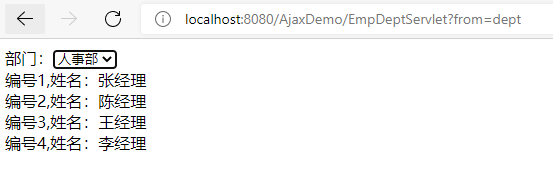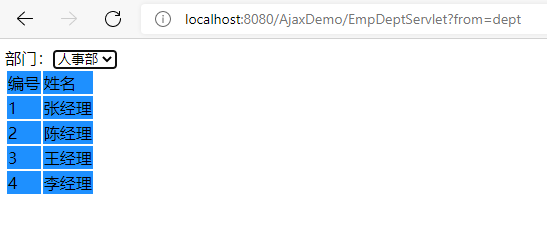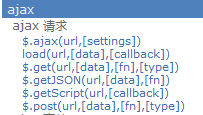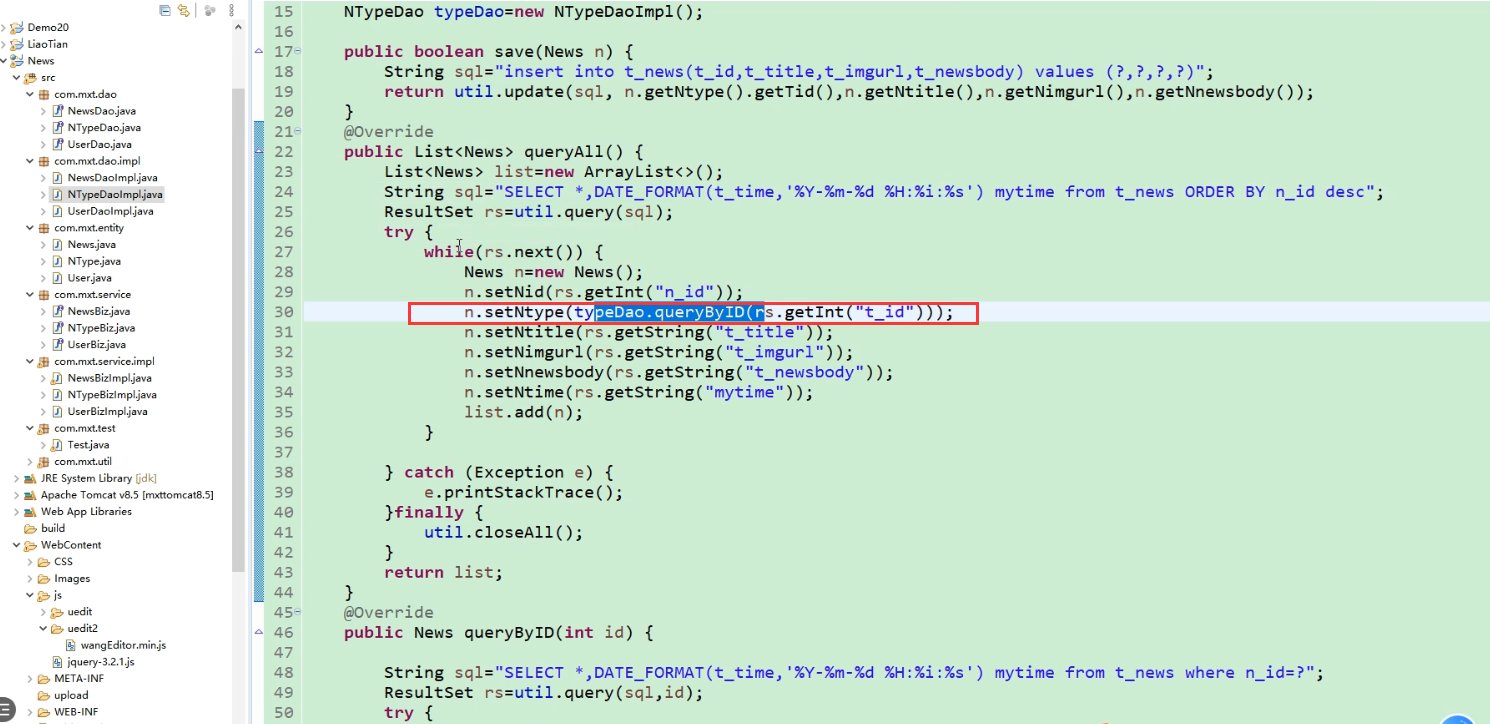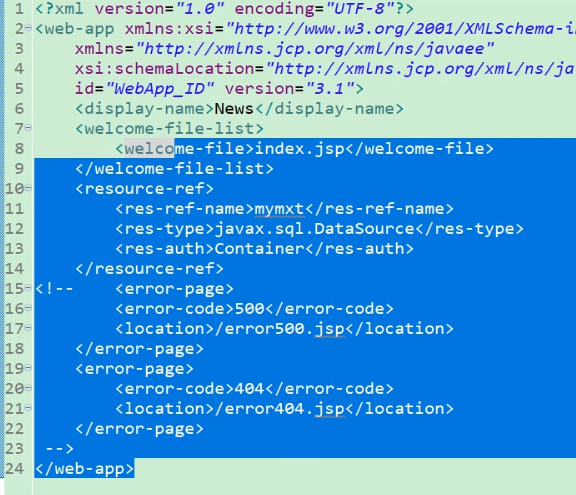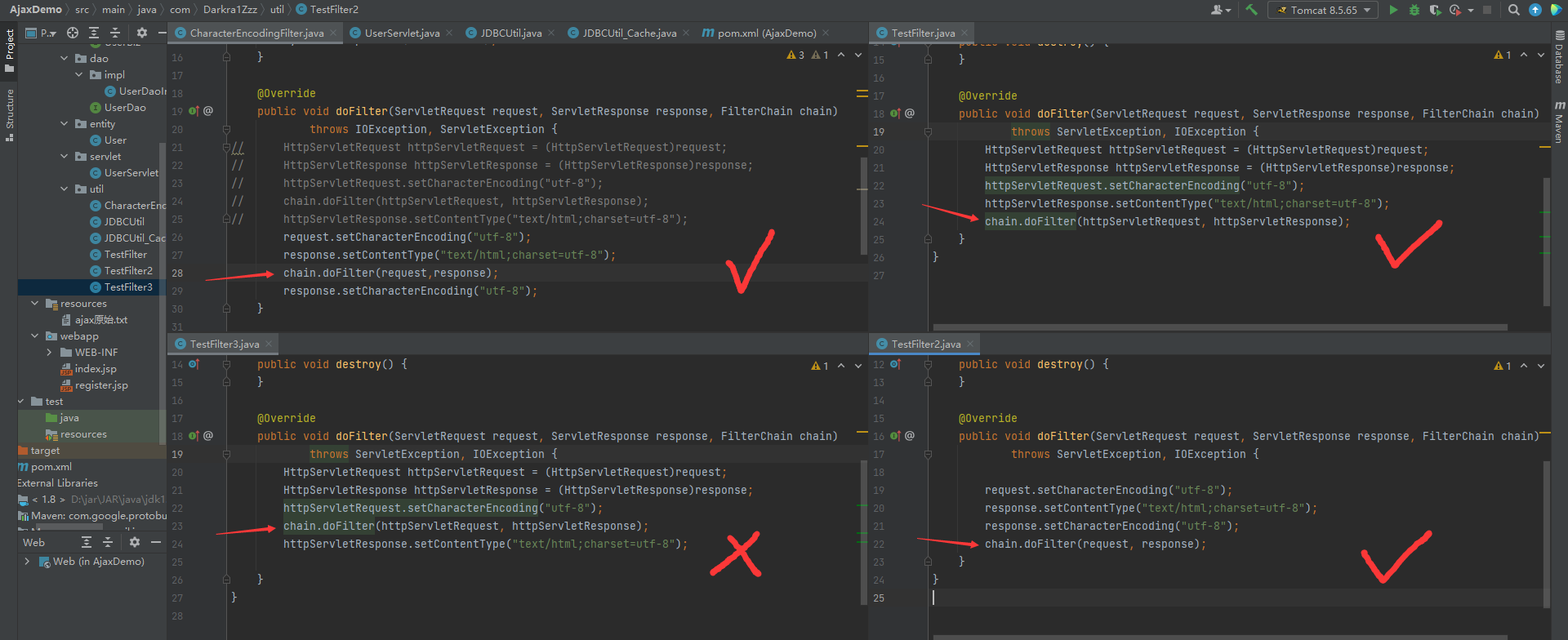学习Ajax过程的一些笔记。
Ajax 是什么
局部刷新技术,避免浪费带宽资源。例如 若页面只发生小部分变化,却要将整个页面重新加载一次。
是Web2.0提出的一种技术,现在已经是Web3.0-4.0了
核心是XMLHttpRequest 用于请求到服务器并获得返回结果并调用回调函数
ajax是一种技术方案,但并不是一种新技术 。它依赖的是现有的CSS/HTML/Javascript,而其中最核心的依赖是浏览器提供的XMLHttpRequest对象,是这个对象使得浏览器可以发出HTTP请求与接收HTTP响应。—– 你真的会使用XMLHttpRequest吗?
怎么用
步骤
需要一个javascript方法 用来启动ajax
在这个方法内判断浏览器是否支持XMLHttpRequest,因为需要浏览器和XMLHttpRequest对象传递数据.
如果支持,则new出XMLHttpRequest对象
设置XMLHttpRequest对象的参数 包括需要传递到服务器的参数,传递方式,回调函数(从服务器接受到数据库后调用的方法)等。。
写回调函数(回调方法)
ajax不能使用转发和重定向进行页面跳转 这会使整个页面刷新,只能通过PrintWriter输出内容
通过status和readystate判断XMLHttpRequest是否获得服务器回传的数据
XMLHttpRequest常用方法与属性
JavaScript对象XMLHttpRequest是整个Ajax技术的核心,它提供了异步发送请求的能力
open(method,URL,async) :建立与服务器的连接,method参数指定请求的HTTP方法,典型的值是GET或POSTURL参数指定请求的地址,async参数指定是否使用异步请求,其值为true(异步)或false(同步)。正常情况都选true 不然用个啥ajax
send(content) :发送请求content参数指定请求的参数
setRequestHeader(header,value) :如果采用post就要设置请求的头信息
onreadystatechange:指定回调函数(事件)
readyState
0:XMLHttpRequest对象没有完成初始化
1:XMLHttpRequest对象开始发送请求
2:XMLHttpRequest对象的请求发送完成
3:XMLHttpRequest对象开始读取响应,还没有结束
4:XMLHttpRequest对象读取响应结束
status
200:服务器响应正常
400:无法找到请求的资源
403:没有访问权限
500:服务器内部错误
responseText:获得响应的文本内容
responseXML:获得响应的XML文档对象
就绪状态是4而且状态码是200,才可以处理服务器数据
第一个例子 判断用户名是否已被注册
register.jsp
1 2 3 4 5 6 7 8 9 10 11 12 13 14 15 16 17 18 19 20 21 22 23 24 25 26 27 28 29 30 31 32 33 34 35 36 37 38 39 40 41 42 43 44 45 46 47 48 49 50 51 52 53 54 55 <html> <head> <title>AjaxDemo</title> <script type="text/javascript" > var httpRequest = null ; function checkName (oval) { if (oval=="" ){ return ; } try { httpRequest = new ActiveXObject("Msxml2.XMLHTTP" ); } catch (e) { try { httpRequest = new ActiveXObject("Microsoft.XMLHTTP" ); } catch (e) { try { httpRequest = new XMLHttpRequest(); if (httpRequest.overrideMimeType) { httpRequest.overrideMimeType("text/xml" ); } } catch (e) { } } } if (httpRequest == null ) { alert("浏览器不支持XMLHttpRequest" ); return ; } httpRequest.open("post" , "UserServlet" , true ); httpRequest.setRequestHeader("Content-type" ,"application/x-www-form-urlencoded" ); httpRequest.onreadystatechange = callBack; httpRequest.send("uname=" + oval); } function callBack () { if (httpRequest.readyState==4 && httpRequest.status==200 ){ document.getElementById("namespan" ).innerHTML=httpRequest.responseText; } } </script> </head> <body> <form action="RegisterServlet" method="post" enctype="application/x-www-form-urlencoded" > <p>姓名:<input type="text" onblur="checkName(this.value)" /> <span id="namespan" >请输入用户名</span> </p> <p>密码:<input type="password" /></p> <p><input type="submit" value="提交" ></p> </form> </body> </html>
UserServlet
1 2 3 4 5 6 7 8 9 10 11 12 13 14 15 16 17 18 19 20 21 22 23 24 25 @WebServlet(name = "UserServlet", value = "/UserServlet") public class UserServlet extends HttpServlet @Override protected void doGet (HttpServletRequest request, HttpServletResponse response) throws ServletException, IOException doPost(request,response); } @Override protected void doPost (HttpServletRequest request, HttpServletResponse response) throws ServletException, IOException HttpSession session=request.getSession(); ServletContext application=getServletContext(); UserBiz userBiz=new UserBizImpl(); String uname=request.getParameter("uname" ); boolean flag=userBiz.checkName(uname); PrintWriter out=response.getWriter(); out.print("<h1>你好,Darkra1</h1>" ); out.print(flag?"用户名可用" :"用户名已存在" ); out.flush(); out.close(); } }
。。感觉前端也得补补了
onblur 事件会在对象失去焦点时发生。
上一个例子实现了使用ajax传递简单参数,传递的方式是键值对匹配,但当参数多起来时就不方便传递
Ajax传递List 实现ajax 前端向后端传递List 并在后端用Gson将List转为Json格式的字符串回传到前端
两种方式实现:
第一种是直接传,但是这样需要在前端接收回传过来的数据时 重新进行拼接form标签之类的 不太方便。
第二种在中间增加一个页面作为中转站,把List转发到一个新的页面 在页面内形成一个form表单 可以带css样式,再将这个页面作为一个整体回传到前端。
但是这里没有使用out.print作为输出方式 不太懂为什么不用out.print也能实现。埋个坑。
empdept.jsp
1 2 3 4 5 6 7 8 9 10 11 12 13 14 15 16 17 18 19 20 21 22 23 24 25 26 27 28 29 30 31 32 33 34 35 36 37 38 39 40 41 42 43 44 45 46 47 48 49 50 51 52 53 54 55 56 <html> <head> <base href="<%=basePath%>" > <title>Title</title> <script type="text/javascript" > var httpRequest = null ; function getemp (obj) { try { httpRequest = new ActiveXObject("Msxml2.XMLHTTP" ); } catch (e) { try { httpRequest = new ActiveXObject("Microsoft.XMLHTTP" ); } catch (e) { try { httpRequest = new XMLHttpRequest(); if (httpRequest.overrideMimeType) { httpRequest.overrideMimeType("text/xml" ); } } catch (e) { } } } if (httpRequest == null ) { alert("浏览器不支持XMLHttpRequest" ); return ; } httpRequest.open("post" , "EmpDeptServlet" , true ); httpRequest.setRequestHeader("Content-type" , "application/x-www-form-urlencoded" ); httpRequest.onreadystatechange = getempback; httpRequest.send("from=emp&did=" +obj.value); } function getempback () { if (httpRequest.readyState == 4 && httpRequest.status == 200 ) { var object = httpRequest.responseText; object=JSON.parse(object); var str="" ; for (var i=0 ;i<object.length;i++){ str+="编号" +object[i].eid+",姓名:" +object[i].ename+"<br/>" ; } document.getElementById("mydiv" ).innerHTML =str; } } </script> </head> <body> 部门:<select id="dep" onchange="getemp(this)" > <c:forEach var ="d" items="${deptList}" > <option value="${d.did}" >${d.dname}</option> </c:forEach> </select> <div id="mydiv" ></div> </body> </html>
empdept2.jsp
将empdept.jsp中的getempback方法改成下面这样
1 2 3 4 5 6 function getempback () { if (httpRequest.readyState == 4 && httpRequest.status == 200 ) { var object = httpRequest.responseText; document.getElementById("mydiv" ).innerHTML =object; } }
httpRequest.send方法改成下面这样
1 httpRequest.send("from=emp2&did="+obj.value); //将要传递的参数传递到后端
empdept2_emp.jsp
1 2 3 4 5 6 7 8 9 10 11 12 13 14 15 16 17 18 19 20 21 22 23 24 25 26 27 28 <html> <head> <base href="<%=basePath%>" > <title>Title</title> <style type="text/css" > table{ border: aqua; } td{ background: dodgerblue; } </style> </head> <body> <table> <tr> <td>编号</td> <td>姓名</td> </tr> <c:forEach items="${empList}" var ="e" > <tr> <td>${e.eid}</td> <td>${e.ename}</td> </tr> </c:forEach> </table> </body> </html>
EmpDepServlet.java
1 2 3 4 5 6 7 8 9 10 11 12 13 14 15 16 17 18 19 20 21 22 23 24 25 26 27 28 29 30 31 32 33 34 35 36 37 38 39 40 41 42 43 44 45 46 47 48 49 50 51 52 53 54 55 56 57 58 @WebServlet(name = "EmpDeptServlet", value = "/EmpDeptServlet") public class EmpDeptServlet extends HttpServlet @Override protected void doGet (HttpServletRequest request, HttpServletResponse response) throws ServletException, IOException doPost(request,response); } @Override protected void doPost (HttpServletRequest request, HttpServletResponse response) throws ServletException, IOException String from=request.getParameter("from" ); if ("dept" .equals(from)){ List<Dept> deptList=new ArrayList<>(); deptList.add(new Dept(1 ,"技术部" )); deptList.add(new Dept(2 ,"人事部" )); request.setAttribute("deptList" ,deptList); request.getRequestDispatcher("empdept2.jsp" ).forward(request,response); }else if ("emp" .equals(from)){ PrintWriter out=response.getWriter(); int did=Integer.valueOf(request.getParameter("did" )); System.out.println(did); List<Emp> empList=new ArrayList<>(); if (did==1 ){ empList.add(new Emp(1 ,"张工程师" )); empList.add(new Emp(2 ,"陈工程师" )); empList.add(new Emp(3 ,"王工程师" )); empList.add(new Emp(4 ,"李工程师" )); }else { empList.add(new Emp(1 ,"张经理" )); empList.add(new Emp(2 ,"陈经理" )); empList.add(new Emp(3 ,"王经理" )); empList.add(new Emp(4 ,"李经理" )); } Gson gson=new Gson(); String str=gson.toJson(empList); System.out.println(str); out.print(str); out.flush(); out.close(); }else if ("emp2" .equals(from)){ int did=Integer.valueOf(request.getParameter("did" )); System.out.println(did); List<Emp> empList=new ArrayList<>(); if (did==1 ){ empList.add(new Emp(1 ,"张工程师" )); empList.add(new Emp(2 ,"陈工程师" )); empList.add(new Emp(3 ,"王工程师" )); empList.add(new Emp(4 ,"李工程师" )); }else { empList.add(new Emp(1 ,"张经理" )); empList.add(new Emp(2 ,"陈经理" )); empList.add(new Emp(3 ,"王经理" )); empList.add(new Emp(4 ,"李经理" )); } request.setAttribute("empList" ,empList); request.getRequestDispatcher("empdept2_emp.jsp" ).forward(request,response); } } }
第一种方式:
第二种方式:
第二种方式更好用 方便做样式。
jQuery-Ajax 上面使用ajax的方式现在已经没人用了 单纯为了介绍ajax原理。
下面介绍jQuery封装好的ajax 更方便使用
jquery-ajax请求一共有以上几种方法
第一个**$.ajax**是万能用法。可以满足所有场景的使用 且比其他方法多了success和error情况。掌握这个就够用了 其他的了解了解即可
第二个load 用法只能将回调得到的参数直接显示在某个区域,不太好用。
第三个$.get和第六个$.post用法差不多 区别在于一个是get请求 一个是post请求。
第四种$.getJSON和$.get的区别在于 它已经将Json格式转化为对象 可以省去data=JSON.parse(data);这一步
第五种没啥用。
注:$.ajax中error方法的参数,可以通过alert(XMLHttpRequest.status + “—-“ + textStatus);打印错误信息
1 2 3 4 5 function (XMLHttpRequest, textStatus, errorThrown) { // 通常 textStatus 和 errorThrown 之中 // 只有一个会包含信息 this; // 调用本次AJAX请求时传递的options参数 }
实际用法看下面↓↓↓
参数传递 multiParameter.jsp
1 2 3 4 5 6 7 8 9 10 11 12 13 14 15 16 17 18 19 20 21 22 23 24 25 26 27 28 29 30 31 32 33 34 35 36 37 38 39 40 41 42 43 44 45 46 47 48 49 50 51 52 53 54 55 56 57 58 59 60 61 62 63 64 65 66 67 68 69 70 71 72 73 74 75 76 77 78 79 80 81 82 83 84 85 86 87 88 89 90 91 92 93 94 95 96 97 98 99 100 101 102 103 104 105 106 107 108 109 110 111 112 113 114 115 116 117 118 119 120 121 122 123 <html> <head> <base href="<%=basePath%>" > <title>Title</title> <script type="text/javascript" src="http://lib.sinaapp.com/js/jquery/2.0.3/jquery-2.0.3.min.js" ></script> <script type="text/javascript" > function getData (object) { $.get("MultiParaServlet" , {name: object, from: "case1" }, function (data) { var strs = data.split("!" ); $('#s1' ).html(strs[0 ]); $('#s2' ).html(strs[1 ]); }); } function getData2 (object) { $.get("MultiParaServlet" , {name: object, from: "case2" }, function (data) { data = JSON.parse(data); $('#s3' ).html(data.name); $('#s4' ).html(data.password); }); } function getData3 (object) { $.getJSON("MultiParaServlet" , {name: object, from: "case3" }, function (data) { $('#s5' ).html(data.name); $('#s6' ).html(data.password); }); } function getBtn () { $.ajax({ url: "MultiParaServlet" , type: "get" , data: {name: "aa" , from: "case4" }, success: function (data) { alert(typeof (data)); alert(data); }, error: function (XMLHttpRequest, textStatus) { alert(XMLHttpRequest.status + "----" + textStatus); } }) } function postBtn () { $.ajax({ url: "MultiParaServlet" , type: "post" , data: {name: "aa" , from: "case4" }, success: function (data) { alert(typeof (data)); alert(data); }, error: function (XMLHttpRequest, textStatus) { alert(XMLHttpRequest.status + "----" + textStatus); } }) } function postBtn2 () { $.ajax({ url: "MultiParaServlet" , type: "post" , data: {name: "aa" , from: "case4" }, dataType: "json" , success: function (data) { alert(typeof (data)); alert(data); alert(data.name+"---" +data.password); }, error: function (XMLHttpRequest, textStatus) { alert(XMLHttpRequest.status + "----" + textStatus); } }) } </script> </head> <body> (用于测试$.ajax) <input type="button" value="get请求" onclick="getBtn()" /> <input type="button" value="post请求" onclick="postBtn()" /> <input type="button" value="post请求Json格式" onclick="postBtn2()" /> <br/> <br/> <br/> <br/> (用于测试$.get 分割多参数进行传递) <br/> 请输入用户名aa或bb: <input type="text" onblur="getData(this.value)" /> <br/>区域1 : <span id="s1" ></span> <br/>区域2 : <span id="s2" ></span> <br/> <br/> <br/> <br/> (用于测试$.get+JSON.parse传递对象) <br/> 请输入用户名aa或bb: <input type="text" onblur="getData2(this.value)" /> <br/>区域3 : <span id="s3" ></span> <br/>区域4 : <span id="s4" ></span> <br/> <br/> <br/> <br/> (用于测试$.getJSON 传递对象) <br/> 请输入用户名aa或bb: <input type="text" onblur="getData3(this.value)" /> <br/>区域5 : <span id="s5" ></span> <br/>区域6 : <span id="s6" ></span> </body> </html>
MultiParaServlet.java
1 2 3 4 5 6 7 8 9 10 11 12 13 14 15 16 17 18 19 20 21 22 23 24 25 26 27 28 29 30 31 32 33 34 35 36 37 38 39 40 41 42 43 44 45 46 47 48 49 50 51 52 53 54 55 56 57 58 59 60 @WebServlet(name = "MultiParaServlet", value = "/MultiParaServlet") public class MultiParaServlet extends HttpServlet @Override protected void doGet (HttpServletRequest request, HttpServletResponse response) throws ServletException, IOException doPost(request,response); } @Override protected void doPost (HttpServletRequest request, HttpServletResponse response) throws ServletException, IOException String from = request.getParameter("from" ); String name = request.getParameter("name" ); PrintWriter out = response.getWriter(); if ("case1" .equals(from)) { if ("aa" .equals(name)) { out.print("aa!男" ); } if ("bb" .equals(name)) { out.print("bb!女" ); } } else if ("case2" .equals(from)){ User user=new User(); if ("aa" .equals(name)){ user.setName("测试get1" ); user.setPassword("123" ); } if ("bb" .equals(name)){ user.setName("测试get2" ); user.setPassword("456" ); } Gson gson=new Gson(); String str=gson.toJson(user); out.print(str); } else if ("case3" .equals(from)){ User user=new User(); if ("aa" .equals(name)){ user.setName("测试a" ); user.setPassword("123" ); } if ("bb" .equals(name)){ user.setName("测试b" ); user.setPassword("456" ); } Gson gson=new Gson(); String str=gson.toJson(user); out.print(str); } else if ("case4" .equals(from)){ User user=new User(); if ("aa" .equals(name)){ user.setName("测试1" ); user.setPassword("123" ); } if ("bb" .equals(name)){ user.setName("测试2" ); user.setPassword("456" ); } Gson gson=new Gson(); String str=gson.toJson(user); out.print(str); } } }
这个例子介绍的都是简单的传递参数方式,实际开发过程中需要传递的参数比较复杂,可能是表单,文件,对象。。。 下面介绍开发时常用的传值方式。
前端向后端传值 普通jQuery-ajax方式 frontToBack.jsp
1 2 3 4 5 6 7 8 9 10 11 12 13 14 15 16 17 18 19 20 21 22 23 24 25 26 27 28 29 30 31 32 33 34 35 36 37 38 39 40 41 42 43 44 45 46 47 48 49 50 51 52 53 54 55 56 57 58 59 <html> <head> <base href="<%=basePath%>" > <title>AjaxDemo</title> <script src="js/jquery-3.2.1.js" ></script> <script type="text/javascript" > function send () { var object=new Object(); object.name=$('#name' ).val(); object.age=$('#age' ).val(); object.password=$('#password' ).val(); var str=JSON.stringify(object); $.post("FrontToBackServlet?method=send" ,{user:str},function (data){ alert(data); }); } function send2 () { var list=[]; for (var i=0 ;i<3 ;i++){ var object=new Object(); object.name="姓名" +i; object.age=10 +i; object.password="密码" +i; list.push(object); } var str=JSON.stringify(list); $.post("FrontToBackServlet?method=send2" ,{users:str},function (data){ alert(data); }); } function send3 () { var object=new Object(); object.name=$('#name' ).val(); object.age=$('#age' ).val(); object.password=$('#password' ).val(); var str=JSON.stringify({ "user" :object, "msg" :"testMap" , "num" :99 }); alert(str); $.post("FrontToBackServlet?method=send3" ,{str:str},function (data){ data=JSON.parse(data); alert(data); $('#s' ).html(data.name); }); } </script> </head> <body> <p>姓名:<input type="text" id="name" /></p> <p>年龄:<input type="text" id="age" /></p> <p>密码:<input type="password" id="password" /></p> <p><input type="button" value="发送数据" onclick="send()" /></p> <p><input type="button" value="发送数组" onclick="send2()" /></p> <p><input type="button" value="发送Map" onclick="send3()" /></p> <span id="s" ></span> </body> </html>
FrontToBackServlet.java
1 2 3 4 5 6 7 8 9 10 11 12 13 14 15 16 17 18 19 20 21 22 23 24 25 26 27 28 29 30 31 32 33 34 35 36 37 38 39 40 41 42 43 44 45 46 47 48 49 50 51 52 53 54 55 56 57 58 59 60 @WebServlet(name = "FrontToBackServlet", value = "/FrontToBackServlet") public class FrontToBackServlet extends HttpServlet @Override protected void doGet (HttpServletRequest request, HttpServletResponse response) throws ServletException, IOException doPost(request,response); } @Override protected void doPost (HttpServletRequest request, HttpServletResponse response) throws ServletException, IOException String method = request.getParameter("method" ); if ("send" .equals(method)) { this .send(request, response); }if ("send2" .equals(method)) { this .send2(request, response); }if ("send3" .equals(method)) { this .send3(request, response); } } private void send (HttpServletRequest request, HttpServletResponse response) throws ServletException, IOException String str=request.getParameter("user" ); Gson gson=new Gson(); User user=gson.fromJson(str,User.class); System.out.println(user); PrintWriter out=response.getWriter(); out.print("后端接收到了,并返回" +user.getName()); out.flush(); out.close(); } private void send2 (HttpServletRequest request, HttpServletResponse response) throws ServletException, IOException String str=request.getParameter("users" ); Gson gson=new Gson(); List<User> users=gson.fromJson(str,new TypeToken<List<User>>(){}.getType()); for (User u:users){ System.out.println(u); } PrintWriter out=response.getWriter(); out.print("后端接收到了,并返回" +users.size()); out.flush(); out.close(); } private void send3 (HttpServletRequest request, HttpServletResponse response) throws ServletException, IOException String str=request.getParameter("str" ); Gson gson=new Gson(); Map<String,Object> map=gson.fromJson(str,new TypeToken<Map<String,Object>>(){}.getType()); System.out.println(map.get("num" )); System.out.println(map.get("msg" )); User user=gson.fromJson(map.get("user" ).toString(),User.class); System.out.println(user); String u=gson.toJson(user); System.out.println("打印user:" +u); PrintWriter out=response.getWriter(); out.print("copy that,return" +u); out.flush(); out.close(); } }
最后这个send3 有报错 一个坑,待填。
表单序列化serialize ref ajax提交form表单 jQuery ajax - serialize() 方法
1 2 3 4 5 6 7 8 9 10 11 12 13 14 15 16 17 18 19 20 21 22 23 24 25 26 27 28 29 30 <head> <base href="<%=basePath%>" > <title>serialize测试</title> <script type="text/javascript" src="http://lib.sinaapp.com/js/jquery/2.0.3/jquery-2.0.3.min.js" ></script> <script type="text/javascript" > function getBtn () { $.ajax({ url: "serialize" , type: "post" , data: $('#myForm' ).serialize(), enctype: 'multipart/form-data' , success: function (data) { console.log(data); alert(data); }, error: function (err) { alert(err); } }); } </script> </head> <body> <form id="myForm" > <p>First name: <input type="text" name="fname" /></p> <p>Last name: <input type="text" name="lname" /></p> <input type="button" value="表单序列化" onclick="getBtn()" /> </form> </body> </html>
1 2 3 4 5 6 7 8 9 10 11 12 13 14 15 16 17 18 19 @WebServlet(name = "SerializeServlet", value = "/serialize") public class SerializeServlet extends HttpServlet @Override protected void doGet (HttpServletRequest request, HttpServletResponse response) throws ServletException, IOException doPost(request,response); } @Override protected void doPost (HttpServletRequest request, HttpServletResponse response) throws ServletException, IOException String fname = request.getParameter("fname" ); String lname = request.getParameter("lname" ); System.out.println(fname); System.out.println(lname); PrintWriter out=response.getWriter(); out.print(fname+"-----" +lname); out.flush(); out.close(); } }
这里只说明了简单用法
表单序列化原理埋个坑 以后再说
JDBC 补补JDBC..
解决java中内存泄漏的最好办法 是谁创建谁消除。所以在每次调用JDBCUtil中的方法时,都会在结束时接着调用closeAll方法
1 2 3 4 5 6 7 8 9 10 11 12 public void closeAll () try { if (rs != null ) rs.close(); if (ps != null ) ps.close(); if (con != null ) con.close(); } catch (Exception e) { e.printStackTrace(); } }
但发生这种情况时,程序会报错。
可能出现的报错 当Dao层方法调用一次JDBCUtil对象内的增删改查方法,且在该Dao层方法内还未进行至第一次调用JDBCUtil.closeAll()方法时,又调用了一次Dao层方法,JDBCUtil对象内的增删改查方法也跟着又被调用了。即嵌套调用JDBCUtil对象内的增删改查方法。此时先进入嵌套内的JDBCUtil.增删改查方法,结束嵌套内方法时才开始第一次调用JDBCUtil.closeAll()。但由于PreparedStatement,ResultSet,Connection是全局变量,所以在第一次调用JDBCUtil.closeAll()时就将这三个全局变量给close了。嵌套内的方法结束后,外层的方法继续执行,但由于JDBCUtil对象内的PreparedStatement,ResultSet,Connection都被嵌套内的方法close了,嵌套外的方法就无法继续执行增删改查操作。
还有一种报错情况就是数据库连接数超过了最大连接数。
不同数据库都有默认的最大连接数,mysql可能是在安装时设置的。
解决方案 加个缓存 将查询到的东西先放进缓存 这样rs关就关咯 用缓存了 谁还管rs啊(大概知道怎么回事。。说不清楚。。蒙混过关。。以后再填。。)
ref
为什么要使用CachedRowSetImpl?
单个用户使用前提。什么情况下会使数据库连接数超过数据库最大连接数? 埋个坑..
Servlet 补补Servlet..
是什么
侠义的Servlet是指Java语言实现的一个接口,广义的Servlet是指任何实现了这个Servlet接口的类,一般情况下,人们将Servlet理解为后者。引自一篇百度知道回答
是在服务器上运行以处理客户端请求并做出响应的程序。是sun推出的用来在服务器处理HTTP协议的组件。
Servlet 是一个 Java程序,是在服务器上运行以处理客户端请求并做出响应的程序
历史,以及与jsp的关系
一篇知乎文章:浅谈jsp
大概总结一下:
servlet是用来帮助程序员更好进行web开发的一些”工具类”。最早没有servlet的时候java和html不好结合在一起。于是出现了servlet帮助java和html结合起来。换句话说,servlet是帮助联系前端和后端的东西。
但是servlet还是有一点点的不好用,因为servlet再怎么厉害也是个java类,它虽然能帮助接受和传递前端传来的东西,但不好处理前端的东西,于是出现了servlet升级版,jsp(本质还是servlet,但是可以更方便的处理和接受传递前端传来的信息,很大的原因在于jsp有九大内置对象)。jsp靠服务器生存,因为必须要服务器内的一个专门用来将Jsp解析成servlet的东西才能用jsp。
Servlet能够很好地组织业务逻辑代码,但是在Java源文件中通过字符串拼接的方式生成动态HTML内容会导致代码维护困难、可读性差
JSP虽然规避了Servlet在生成HTML内容方面的劣势,但是在HTML中混入大量、复杂的业务逻辑同样也是不可取的。
jsp更擅长表现于页面显示,servlet更擅长于逻辑控制。
所以后来出现了mvc 。
什么是jsp
JSP全名为Java Server Pages
在HTML中嵌入Java脚本代码
由应用服务器中的JSP引擎来编译和执行嵌入的Java脚本代码
然后将生成的整个页面信息返回给客户端
JSP的本质就是Servlet,JVM只能识别java的类,不能识别JSP的代码,Web容器将JSP的代码编译成JVM能够识别的java类
JSP九大内置对象 JSP九大内置对象与他们对应的java对象
servlet
java
作用
Request
HttpServletRequest
封装了用户提交的数据(请求)
Response
HttpServletResponse
封装了要发送给客户端的数据(相应)
Session
HttpSession
会话,有效期是在浏览器开启到关闭之间在服务器端保存数据
Application
ServletContext
有效期是服务器开启到关闭之间,多个用户和浏览器之间可以共享数据
Out
PrintWriter
往客户端输出数据,可以写文字,可以写html标签,可以写js
pageContext
PageContext
只在本页面有效,但是由于通过servlet转到到界面,所以pageContext没什么用
Page
this
获取当前页面的对象,默认可以省略不写
Config
ServletConfig
sevlet的配置文件,用于获取ServletContext和web.xml/注解中定义的初始化参数
Exception
throwable
页面中的异常对象,默认不需要写
配置error界面
过滤器 过滤器的生命周期分为
实例化
初始化
过滤
销毁
在服务器启动的时候自动创建并Init实例化
一个问题: 只是调整了chain.doFilter(request,response);的执行顺序。
1,2,4都可以起到过滤器的效果 运行不会出现乱码,但是3不行。
未解决。
Learn from 莫筱婷
Ref 你不知道的 XMLHttpRequest
XMLHttpRequest—必知必会
浏览器之XMLHttpRequest实现机制
Ajax中的XMLHttpRequest对象详解
AJAX入门这一篇就够了
